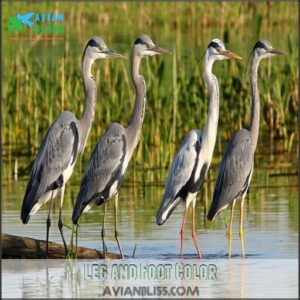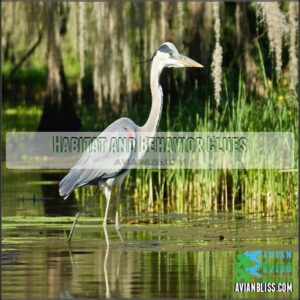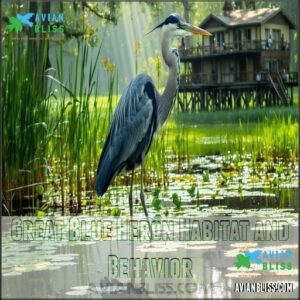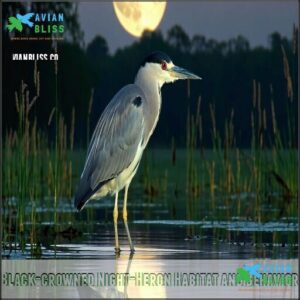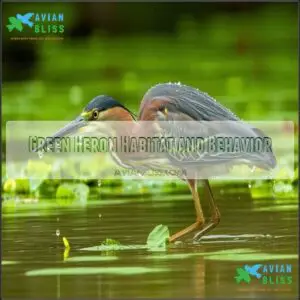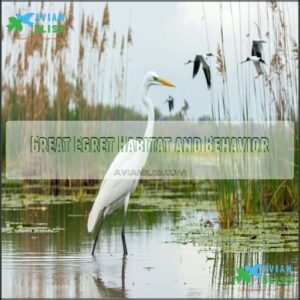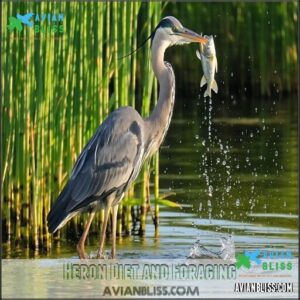This site is supported by our readers. We may earn a commission, at no cost to you, if you purchase through links.

The Great Blue Heron, with its graceful stature and dagger-like beak, is a frequent sight, while the Green Heron’s clever fishing tricks might surprise you.
You might also spot the elusive American Bittern blending into reeds or the Black-crowned Night-Heron sneaking a twilight snack.
Don’t forget the regal Great Egret, a true icon of elegance.
These birds play important roles in local ecosystems, keeping fish populations in check. Georgia’s herons bring life to its waters—stick around to discover what makes each species so remarkable!
Table Of Contents
- Key Takeaways
- Herons in Georgia Overview
- Heron Species Identification
- Heron Habitat and Behavior
- Heron Diet and Foraging
- Heron Conservation Status
- Frequently Asked Questions (FAQs)
- Are herons common in Georgia?
- Did I see a crane or a heron?
- How do you tell the difference between an egret and a heron?
- What is the difference between a GREY heron and a Great Blue Heron?
- Are there herons in Georgia?
- Is there a difference between a Great Blue Heron and a blue heron?
- What birds are mistaken for herons?
- Is there a difference between a great blue heron and a blue heron?
- What herons live in Georgia?
- What is the difference between a heron and an egret in Georgia?
- Conclusion
Key Takeaways
- You’ll find five main heron species in Georgia’s wetlands, including the Great Blue Heron, Green Heron, and Great Egret.
- Herons are skilled hunters with unique behaviors like the Green Heron using tools to lure fish and the Black-crowned Night-Heron hunting at night.
- Georgia’s herons face threats like habitat loss and pollution, but conservation efforts like wetland restoration and colony protection are helping.
- You can identify herons by plumage, beak shape, and leg color, with Great Blue Herons having bluish-gray feathers and Great Egrets showing pure white plumage.
Herons in Georgia Overview
You’ll find five amazing heron species in Georgia’s wetlands, from the majestic Great Blue Heron that stands nearly four feet tall to the sneaky Green Heron that uses bugs as fishing bait.
From towering Great Blue Herons to clever Green Herons baiting fish, Georgia’s wetlands brim with elegance, strategy, and dinosaur-like charm!
Whether you’re watching them at Lake Lanier or along the Roswell Riverwalk, these elegant birds will turn you into an instant bird-watcher with their patient hunting skills and dinosaur-like presence.
Great Blue Heron Characteristics
Georgia’s Great Blue Heron (Ardea herodias) is a magnificent sight you’ll never forget.
A towering icon of Georgia’s wetlands, the Great Blue Heron captures hearts with its elegance, stealth, and unforgettable grace.
This towering bird stands up to 4.5 feet tall with an impressive 6-foot wingspan.
Their characteristics make them efficient hunters, including:
- Their blue-grey plumage blends perfectly with water, making them stealth hunters
- Their dagger-like bill spears fish with lightning precision
- Their S-curved neck can strike prey faster than you can blink
- Their nesting colonies (heronries) can include up to 500 breeding pairs, showcasing their highly social behavior.
American Bittern Habitat
While spotting an American Bittern in Georgia’s wetlands might feel like finding a needle in a haystack, these secretive birds thrive in freshwater marshes with tall, dense vegetation.
You’ll find them year-round in coastal areas, with breeding populations appearing in large marshes during summer months.
| Habitat Type | Season | Behavior |
|---|---|---|
| Freshwater marshes | Year-round | Highly camouflaged |
| Wet meadows | Summer breeding | Stands motionless |
| Flooded willows | Winter | Blends with reeds |
| Salt marshes | Migration periods | Points bill upward |
Conservation challenges like wetland loss threaten their perfect hiding spots, making it essential to protect these areas to preserve the American Bittern and its secretive lifestyle, ensuring the coastal areas remain a safe haven.
Black-crowned Night-Heron Behavior
You’ll marvel at the Black-crowned Night-Heron’s mysterious nighttime habits.
These nocturnal birds have fascinating behaviors that set them apart from other herons in Georgia.
Black-crowned Night-Heron behavior includes:
- Feeding primarily between dusk and dawn with opportunistic hunting techniques
- Nesting in large, noisy colonies with other herons
- Defending both feeding grounds and nesting territories
- Making distinctive "quawk" vocalizations when disturbed
- Showing surprising tolerance toward non-threatening human activities in urban habitats
Green Heron Diet
Among all Georgia herons, the clever Green Heron stands out as one of the few bird species that uses tools.
You’ll be amazed watching these fishing geniuses drop bread crusts or insects as bait to lure unsuspecting fish.
| Diet Component | Fishing Technique |
|---|---|
| Small fish (minnows, sunfish) | Bait fishing with tools |
| Crayfish & insects | Patient stalking |
| Frogs & tadpoles | Dawn/dusk foraging |
| Spiders & earthworms | Perch hunting |
| Seasonal diet variation | Motionless waiting |
Great Egret Migration Patterns
While Green Herons are hunting fish, their elegant cousins are on the move!
Great Egrets in Georgia aren’t homebodies—they’re partial migrants that head south when temperatures drop. These journeys are guided by visual landmarks.
- Migration Triggers include freezing waters that limit fishing opportunities
- Breeding Locations in Georgia become staging areas before winter travel
- Winter Habitats can be up to 621 miles from summer spots
- Flyway Routes have changed as egrets establish new colonies in Nordic countries
You’ll spot these white beauties wandering north after breeding season—nature’s nomads on the wing!
Heron Species Identification
You’ll quickly become a heron-spotting pro when you know what to look for in Georgia’s five magnificent species, from the towering Great Blue to the secretive Green Heron.
Learning their unique features, like the Great Egret’s yellow bill or the Black-crowned Night-Heron’s stocky build, makes your birding adventures much more rewarding than just saying "I saw some big bird near the water.
This allows for a more engaging experience, as you can differentiate between species and appreciate their distinct characteristics, such as the Great Blue.
Size and Plumage Differences
Herons in Georgia impress with their variety in plumage and size.
Great Blue Herons stand tall with striking blue-gray feathers, while Tricolored Herons flaunt lavender touches and white bellies.
Juvenile Little Blue Herons sport an all-white look, creating challenges in subspecies identification.
Regional differences even produce hybrids, like Wurdemann’s Heron, blending traits and showcasing unique bird plumage across habitats.
Some enthusiasts even collect items related to heron color variations.
Beak Shape and Color
Beak morphology is a handy clue for heron identification.
Great Blue Herons boast dagger-like bills, perfect for spearing prey, while the Green Heron’s shorter bill suits stalking fish.
Bill coloration varies: yellow for many species but black-tipped on hybrids.
Feeding adaptations explain these differences, showcasing how heron species in Georgia evolved tools for their menu. Understanding beak shape variations aids identification.
Bird morphology is fascinating and the study of beak shape variations can greatly enhance heron identification skills.
Leg and Foot Color
Leg and foot colors can be surprisingly helpful for heron identification. Great Blue Herons show grayish-black legs, while the Great Egret’s legs are jet-black with yellow feet.
Foot color development often relates to diet; pigments change with habitat and prey. You can find heron leg color products to aid in identification.
Subspecies leg color also varies—watch closely, since these subtle clues make bird species identification more exciting and precise!
Habitat and Behavior Clues
Spotting herons in Georgia? Look for clues in their behavior and habitat:
- Nesting locations: High trees near wetlands house colonies called “heronries.”
- Foraging patterns: They stalk edges of rivers and ponds, striking with precision.
- Territoriality displays: Watch for defensive postures near prime fishing spots.
- Vocalizations: From croaks to caws, their calls echo through bird habitats.
These Georgia birds never disappoint!
Unique Characteristics of Each Species
Distinguishing heron species in Georgia is like spotting personalities at a party.
The great blue heron impresses with its striking plumage variations and slow, stalking hunting style. Little blue herons trade elegant morph differences for stealth.
Green herons, masters of tool use, bait fish cleverly.
Bird skeletons have hollow bones to reduce weight for flight.
Their nesting habits and vocalizations add more flair, making herons truly fascinating to watch with their unique characteristics.
Heron Habitat and Behavior
You’ll find herons across Georgia’s wetlands, rivers, and lakes, where they patiently stalk their prey or rest high in tree canopies.
Watching their graceful movements and clever hunting tactics will leave you amazed—and maybe a little envious of their fishing skills!
Great Blue Heron Habitat and Behavior
The Great Blue Heron, a wading bird icon, thrives near lakes, rivers, and wetlands in Georgia.
You’ll catch them patiently fishing with their signature “S”-shaped neck, expertly spearing prey.
They’re surprisingly territorial, defending prime spots fiercely.
Their plumage variations are breathtaking, from grayish-blue to all-white.
Nesting colonies high in trees showcase their social side, creating bustling hubs of bird behavior.
American Bittern Habitat and Behavior
The American Bittern is a master of marsh camouflage, blending seamlessly into Georgia’s wetlands with its streaked plumage.
Known for its secretive habits, it’s a rare treat to spot one. Listen for its odd “oong-KA-chunk” call during breeding.
Fun facts:
- Stalks prey in tall reeds.
- Regurgitates pellets of indigestible bits.
- Faces conservation challenges due to habitat loss.
- Thrives in diverse bird habitats.
Black-crowned Night-Heron Habitat and Behavior
The Black-crowned Night-Heron thrives in Georgia’s wetlands and urban habitats, often overlooked due to its quiet, nocturnal hunting habits.
These colony-nesting herons favor trees near water for rookeries, filling the air with unique vocalizations.
Conservation challenges affect their habitat, but they adapt well, even foraging in city parks, as graceful hunters under the moonlit sky, showcasing their resourcefulness.
Green Heron Habitat and Behavior
Moving from the Black-crowned Night-Heron’s preferences, the Green Heron thrives in wetlands and dense vegetation across Georgia.
These crafty, tool-using birds lure fish with insects—a behavior you’ve got to see, and their sharp "skeow" call at dawn is a notable sound.
As ambush predators, they forage by stealth, striking quickly, which is a testament to their patience and skill.
- Early mornings reveal their skills,
- Patience pays off,
- Nature amazes!
Great Egret Habitat and Behavior
Shifting from the Green Heron’s clever fishing tricks, the Great Egret steals the show with its elegance.
These wading birds roam wetlands and coastal Georgia, standing tall in shallow water. They are known for egret nesting in treetops, and they’re social, often forming rookeries.
Their foraging strategies include patient stalking for fish. Sadly, habitat threats highlight the need for conservation efforts.
| Behavior | Description | Fun Fact |
|---|---|---|
| Egret Nesting | High in colonies in trees | Nests can reach 4 feet in diameter! |
| Foraging Strategies | Slow stalking in water | They can stand still for minutes. |
| Social Behavior | Rookery-based communities | Strong teamwork guarantees survival. |
Heron Diet and Foraging
Herons are expert hunters, using their sharp bills and patience to catch everything from fish to frogs.
Watching one in action might just make you rethink who’s really at the top of the fishing game!
Great Blue Heron Diet and Foraging
Great Blue Herons are expert anglers with impressive fishing techniques.
Their diet includes fish, frogs, and even small birds.
Here’s how they do it:
- Stand still like statues, waiting patiently for prey.
- Strike fast with an "S"-shaped neck, spearing prey.
- Adapt seasonally, eating what’s available—even koi, frustrating pond owners.
Their foraging showcases remarkable patience and diet adaptability.
They often employ ambush hunting tactics, standing motionless before striking.
American Bittern Diet and Foraging
The American Bittern masters marsh camouflage, blending perfectly while foraging for prey.
Its heron diet includes invertebrates, like insects and crayfish, plus amphibians and small fish.
Secretive hunting is its signature move—patient and stealthy.
After dining, it forms regurgitation pellets to expel undigested bits.
Seasonal diets vary, so its menu depends on what’s available in the wetlands.
Black-crowned Night-Heron Diet and Foraging
The Black-crowned Night-Heron is a master of nocturnal hunting, sneaking through wetlands and streams with keen precision.
This heron species in Georgia thrives on a diverse prey variety—fish, insects, and even small mammals.
Their diet adaptations allow them to forage in different habitats, using clever feeding techniques like waiting patiently or swiftly snapping up unsuspecting prey.
They’re stealthy, not showy, and their ability to forage in different habitats makes them highly adaptable.
Green Heron Diet and Foraging
The Green Heron’s hunting tactics are impressive! These clever herons use tool use, dropping insects or feathers to lure fish within striking distance—a true act of ambush predation.
Their dietary adaptations let them thrive in foraging habitats like dense wetlands.
Their menu includes:
- Small fish and amphibians
- Insects during warmer seasons
- Crustaceans in seasonal prey shifts
They’re nature’s sneaky strategists!
Great Egret Diet and Foraging
Egrets are elegant fishers, but they’re also opportunistic with their prey selection.
Their foraging techniques involve a patient stance or slow stalking along wetlands. Seasonal diet changes include fish, frogs, and insects.
These dietary adaptations boost hunting success year-round. Watching a Great Egret’s focused fishing feels like witnessing a pro angler at work!
| Prey | Common Examples | Seasons Preferred | Hunting Style | Success Rate |
|---|---|---|---|---|
| Fish | Minnows, Trout | Year-Round | Stalking or Standing Still | High |
| Frogs | Tree Frogs | Spring/Summer | Swift Bill Strike | Moderate |
| Insects | Grasshoppers | Summer/Fall | Slow Walk-and-Pick | Moderate |
| Small Reptiles | Lizards | Summer | Ambush Attack | Moderate |
| Small Birds | Nestlings | Rare | Opportunistic Grab | Low |
Heron Conservation Status
Herons in Georgia face challenges like habitat loss and pollution, but there’s still hope for their future.
You can make a difference by supporting conservation efforts and creating heron-friendly spaces in your community.
Threats to Heron Populations
Herons face challenges that threaten their survival in Georgia.
Habitat loss from urban growth destroys essential nesting areas. Pollution impacts water quality, harming prey availability.
Climate change, like rising sea levels, disrupts their habitats. Human disturbance, from motorboats to logging, stresses breeding colonies.
Here are key threats:
- Wetlands destroyed.
- Contaminated waters.
- Rising seas.
- Disruptive human activity.
Conservation Efforts in Georgia
Georgia’s heron conservation efforts focus on Habitat Preservation and Wetland Restoration to protect these incredible birds.
Pollution Reduction plays a big role, keeping their ecosystems healthy.
Colony Protection guarantees safer breeding grounds, while Public Awareness inspires action for bird conservation.
By maintaining bird habitats in Georgia, these efforts safeguard herons and support bird conservation statewide, keeping wetlands full of life!
How You Can Help Protect Herons
Protecting herons is easier than you think! Here’s how:
- Reduce pesticides—fewer chemicals mean safer water for herons.
- Support sanctuaries—donate or volunteer with bird conservation groups.
- Report disturbances—if nesting areas or bird habitats are threatened, notify authorities.
- Practice responsible fishing—avoid leaving lines or hooks behind in heron habitats.
You’ll help keep these majestic birds thriving!
Heron-Friendly Habitat Creation
Creating a heron-friendly habitat is simpler than you’d think.
Start with wetland restoration to provide a safe space for freshwater herons. Add native plantings around water for cover and food.
Control predators responsibly to protect heron nesting sites. Clean water is essential—pollution harms wetland birds.
Herons thrive in diverse saltwater and freshwater habitats. Focus on maintaining space for heron rookeries—they’ll thank you with graceful visits!
| Action | Benefit | Tip |
|---|---|---|
| Wetland Restoration | Supports heron habitat Georgia | Preserve natural water sources. |
| Native Plantings | Food and cover for nesting | Include grasses or cattails. |
| Predator Control | Protects heron rookeries | Use humane deterrents. |
Georgia Birding Communities and Clubs
Joining local birding groups is a fantastic way to explore heron species in Georgia.
These clubs often host guided heron walks, heronry monitoring programs, and community conservation projects.
Georgia birdwatching events regularly feature birding event calendars to stay active year-round.
Whether you’re passionate about Georgia wildlife or spotting majestic heron species, you’ll feel right at home with these communities.
Frequently Asked Questions (FAQs)
Are herons common in Georgia?
Herons are like nature’s sentinels, gracefully patrolling Georgia’s waterways.
You’ll often spot species like the Great Blue Heron near rivers, wetlands, and lakes year-round, showcasing their elegance while hunting fish or nesting in colonies.
Did I see a crane or a heron?
You likely saw a heron!
Cranes are rare in Georgia, while herons, like the Great Blue Heron, are commonly spotted near water.
Look for a long neck forming an "S" shape—it’s a heron trademark!
How do you tell the difference between an egret and a heron?
Imagine spotting a tall bird fishing—if it’s white, it’s likely an egret, but a heron is often grayish-blue.
Egrets are smaller, with sleeker builds, while herons look stockier with broader wings.
What is the difference between a GREY heron and a Great Blue Heron?
A Grey Heron, native to Europe, Asia, and Africa, is smaller, paler, and lacks the Great Blue Heron’s chestnut thighs.
Great Blues, America’s largest herons, flaunt blue-gray feathers and thrive near diverse water habitats.
Are there herons in Georgia?
Ever spotted a tall bird fishing in a lake with a neck like an “S”?
Georgia’s got you covered!
Herons, especially the Great Blue Heron, thrive year-round in the state’s wetlands and waterways.
Is there a difference between a Great Blue Heron and a blue heron?
There’s no actual "blue heron" species—people usually mean the Great Blue Heron.
It’s a majestic, bluish-gray wading bird with a piercing bill, S-shaped neck, and remarkable patience for snagging fish.
What birds are mistaken for herons?
Egrets, cranes, and bitterns are often mistaken for herons.
Their long legs and necks give heron vibes, but close up, you’ll spot differences in size, color, and how they fish or hunt!
Is there a difference between a great blue heron and a blue heron?
You might think "great blue heron" and "blue heron" are interchangeable, but nope!
The great blue heron is a specific species, whereas "blue heron" is a fuzzy nickname folks sometimes use generically.
What herons live in Georgia?
In Georgia, you’ll find Great Blue Herons, Green Herons, and Black-crowned Night-Herons thriving in wetlands, lakes, and rivers.
They’re masters of fishing, and their diverse habits make them local favorites for birdwatchers statewide!
What is the difference between a heron and an egret in Georgia?
Herons and egrets share wetlands, but herons boast majestic plumes and grayish-blue tones, while egrets dazzle in pure white feathers.
It’s like comparing a custom-made suit to a wedding dress—both elegant, yet distinct!
Conclusion
Picture yourself watching a Great Blue Heron silently stalk its prey or a Green Heron using tools to fish—nature’s cleverness at its best.
Herons in Georgia aren’t just beautiful; they’re essential to wetland ecosystems, balancing fish populations while enchanting onlookers.
Whether it’s the flash of the Great Egret’s white plumage or the stealthy American Bittern melting into reeds, these birds are worth your attention.
Grab binoculars and explore—you’ll never see Georgia’s waters the same way again, and discover the cleverness of these birds!




